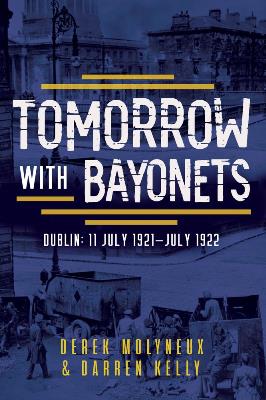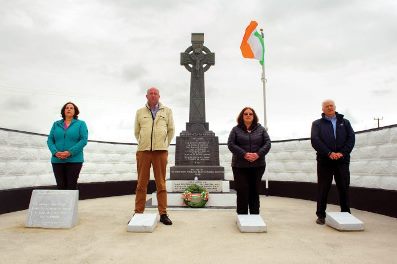
"Tomorrow with Bayonets" and Gortaglanna
If there is such a thing as a definitive account of the Irish Civil War it is "Tomorrow with Bayonets", By Derek Molyneux and Darren Kelly. It is the first of two books dealing with the Civil War in Dublin. From page one it imparts details which earlier historians have missed or chose not to use. How often will you read about the day in 1922 when the National Army fought side-by-side on the Donegal border against the might of far superior numbers of British forces?
How Emmet Dalton, “’gave birth to the first Irish flying
unit” makes interesting reading. During Treaty negotiations he procured a
Martinsyde biplane to get Collins back to Dublin in a hurry if talks
broke down. Lloyd George’s opinion of DeValera to dreadful bloodshed
it’s all there.
There is a blow-by-blow account of Todd Andrews seriously
perturbed by the shortage of tobacco crawling through a tunnel three
feet wide and two feet high, when escaping from the Curragh. Andrews
considered the tunnel very tight and it struck me that his grandson Ryan
Tubridy would have no trouble crawling through such a space! We
learn that during the summer of 1922 three full-time technicians were
engaged to make incendiary bombs. This project was overseen by two names
familiar to GAA fans, 44 year-old Sam Maguire and his close associate
Liam McCarthy.
After the pope wrote to King George V to congratulate him on
the beginning of negotiations the King replied and expressed hope that
the talks, “ May initiate a new era of peace and happiness for my
people.” De Valera lost no time in sending a telegram to the pope, also
thanking him and refuting any misleading allegiance King George’s
telegram might have inferred, particularly with the words, “my people.”
After much deliberation the Anglo-Irish Treaty was approved
in University College Dublin at Earlsfort Terrace on the sixth of
December 1921. There was much jubilation outside the college. Inside the
atmosphere was more subdued until DeValera disrupted the stillness with
an unexpected announcement. He said that it would be his duty now to
resign as chief executive, declaring that the Republic could only be
disestablished by the Irish People and until that happened said the
Republic would continue as the supreme sovereign body in the nation.
Michael Collins said that he would continue to do his best for Ireland
and for his president. Ireland’s war with England was officially over
but there lay times ahead which would have brother fighting against
brother. A dark time in our history causing wounds which wouldn’t even
begin to heal for generations.
Things changed though during that terrible and bloody war.
Who could have predicted that Winston Churchill would write to Collins
with the words, “If I refrain from congratulating you it is only because
I do not wish to embarrass you. The archives of the Four Courts may be
scattered but the title—deeds of Ireland are safe.”
There are 50 notable black and white photos, 47 of which are from the Mercier Archive.

|
|

Irish Eyes
"Tomorrow with Bayonets" and Gortaglanna
If there is such a thing as a definitive account of the Irish Civil War it is "Tomorrow with Bayonets", By Derek Molyneux and Darren Kelly. It is the first of two books dealing with the Civil War in Dublin. From page one it imparts details which earlier historians have missed or chose not to use. How often will you read about the day in 1922 when the National Army fought side-by-side on the Donegal border against the might of far superior numbers of British forces?
How Emmet Dalton, “’gave birth to the first Irish flying
unit” makes interesting reading. During Treaty negotiations he procured a
Martinsyde biplane to get Collins back to Dublin in a hurry if talks
broke down. Lloyd George’s opinion of DeValera to dreadful bloodshed
it’s all there.
There is a blow-by-blow account of Todd Andrews seriously
perturbed by the shortage of tobacco crawling through a tunnel three
feet wide and two feet high, when escaping from the Curragh. Andrews
considered the tunnel very tight and it struck me that his grandson Ryan
Tubridy would have no trouble crawling through such a space! We
learn that during the summer of 1922 three full-time technicians were
engaged to make incendiary bombs. This project was overseen by two names
familiar to GAA fans, 44 year-old Sam Maguire and his close associate
Liam McCarthy.
After the pope wrote to King George V to congratulate him on
the beginning of negotiations the King replied and expressed hope that
the talks, “ May initiate a new era of peace and happiness for my
people.” De Valera lost no time in sending a telegram to the pope, also
thanking him and refuting any misleading allegiance King George’s
telegram might have inferred, particularly with the words, “my people.”
After much deliberation the Anglo-Irish Treaty was approved
in University College Dublin at Earlsfort Terrace on the sixth of
December 1921. There was much jubilation outside the college. Inside the
atmosphere was more subdued until DeValera disrupted the stillness with
an unexpected announcement. He said that it would be his duty now to
resign as chief executive, declaring that the Republic could only be
disestablished by the Irish People and until that happened said the
Republic would continue as the supreme sovereign body in the nation.
Michael Collins said that he would continue to do his best for Ireland
and for his president. Ireland’s war with England was officially over
but there lay times ahead which would have brother fighting against
brother. A dark time in our history causing wounds which wouldn’t even
begin to heal for generations.
Things changed though during that terrible and bloody war.
Who could have predicted that Winston Churchill would write to Collins
with the words, “If I refrain from congratulating you it is only because
I do not wish to embarrass you. The archives of the Four Courts may be
scattered but the title—deeds of Ireland are safe.”
There are 50 notable black and white photos, 47 of which are from the Mercier Archive.

|
|

Irish Eyes
"Tomorrow with Bayonets" and Gortaglanna
If there is such a thing as a definitive account of the Irish Civil War it is "Tomorrow with Bayonets", By Derek Molyneux and Darren Kelly. It is the first of two books dealing with the Civil War in Dublin. From page one it imparts details which earlier historians have missed or chose not to use. How often will you read about the day in 1922 when the National Army fought side-by-side on the Donegal border against the might of far superior numbers of British forces?
How Emmet Dalton, “’gave birth to the first Irish flying
unit” makes interesting reading. During Treaty negotiations he procured a
Martinsyde biplane to get Collins back to Dublin in a hurry if talks
broke down. Lloyd George’s opinion of DeValera to dreadful bloodshed
it’s all there.
There is a blow-by-blow account of Todd Andrews seriously
perturbed by the shortage of tobacco crawling through a tunnel three
feet wide and two feet high, when escaping from the Curragh. Andrews
considered the tunnel very tight and it struck me that his grandson Ryan
Tubridy would have no trouble crawling through such a space! We
learn that during the summer of 1922 three full-time technicians were
engaged to make incendiary bombs. This project was overseen by two names
familiar to GAA fans, 44 year-old Sam Maguire and his close associate
Liam McCarthy.
After the pope wrote to King George V to congratulate him on
the beginning of negotiations the King replied and expressed hope that
the talks, “ May initiate a new era of peace and happiness for my
people.” De Valera lost no time in sending a telegram to the pope, also
thanking him and refuting any misleading allegiance King George’s
telegram might have inferred, particularly with the words, “my people.”
After much deliberation the Anglo-Irish Treaty was approved
in University College Dublin at Earlsfort Terrace on the sixth of
December 1921. There was much jubilation outside the college. Inside the
atmosphere was more subdued until DeValera disrupted the stillness with
an unexpected announcement. He said that it would be his duty now to
resign as chief executive, declaring that the Republic could only be
disestablished by the Irish People and until that happened said the
Republic would continue as the supreme sovereign body in the nation.
Michael Collins said that he would continue to do his best for Ireland
and for his president. Ireland’s war with England was officially over
but there lay times ahead which would have brother fighting against
brother. A dark time in our history causing wounds which wouldn’t even
begin to heal for generations.
Things changed though during that terrible and bloody war.
Who could have predicted that Winston Churchill would write to Collins
with the words, “If I refrain from congratulating you it is only because
I do not wish to embarrass you. The archives of the Four Courts may be
scattered but the title—deeds of Ireland are safe.”
There are 50 notable black and white photos, 47 of which are from the Mercier Archive.

|
|
"Tomorrow with Bayonets" is published by Mercier Press. It is
priced at €19.99. A small price to pay for this work by two brilliant
historians who left no stone unturned in their research.
Link: "www.mercierpress.ie/irish-books/tomorrow-with-bayonets/"
* * * * *

|
|
IT HAPPENED IN MAY
Before the Civil War and prior to the Truce an atrocity took
place in County Kerry which has been recorded in song and story. On 12
May 1921, a troop of Black and Tans were travelling out from Listowel
towards Athea when they arrested four young unarmed men in Gortaglanna.
Prior to this the barracks in Listowel had been burnt out and in
retaliation the troops decided to execute the young men. The first to
be shot was Jerry Lyons. When this happened, Cornelius Dee decided, as
he was going to be shot anyway, to make a run for it. He ran, and almost
immediately took a bullet in the thigh but managed to keep going. He
ran for about three miles. He was never recaptured but remained in
hiding until the truce
In 2021 I interviewed historian, the late, Dan Keane who told
me the story of the song "The Valley of Knockanure" which was written
about the shootings. I’m attaching an audio clip of that interview.
Interview with Dan Keane.wav
Interview with Dan Keane
See you in July..





No comments:
Post a Comment